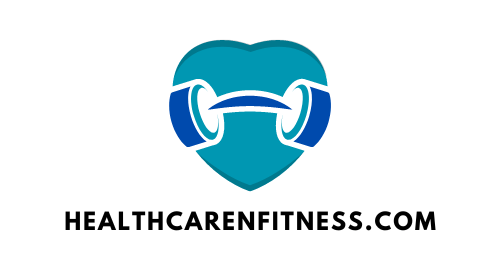What to Do If ? A Comprehensive Guide to Handling Health and Fitness Roadblocks
Embarking on a health and fitness journey can be a thrilling and rewarding experience. You set goals, create a plan, and take steps to reach your desired level of fitness. However, there are often obstacles that can arise along the way. Whether it’s a lack of motivation, injury, or simply feeling stuck in a plateau, it’s important to have a strategy in place to overcome these challenges. In this guide, we’ll explore different “what to do if…” scenarios that you may encounter in your health and fitness journey.

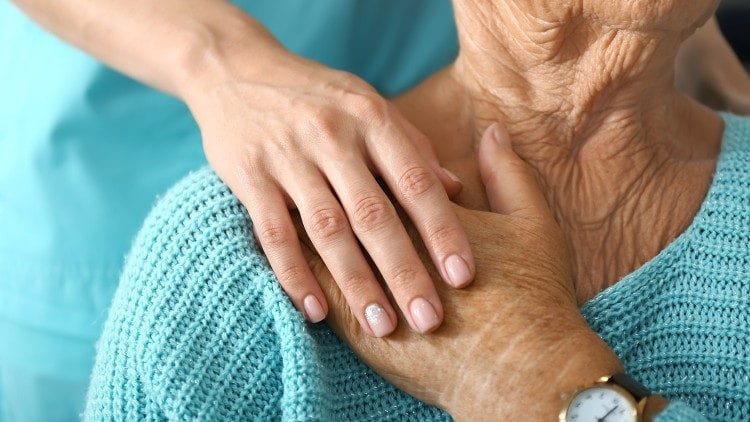
Take some time to learn first aid and CPR. It saves life and it works
Bobby Sherman

1. What to do if a person gets cardiac arrest ?
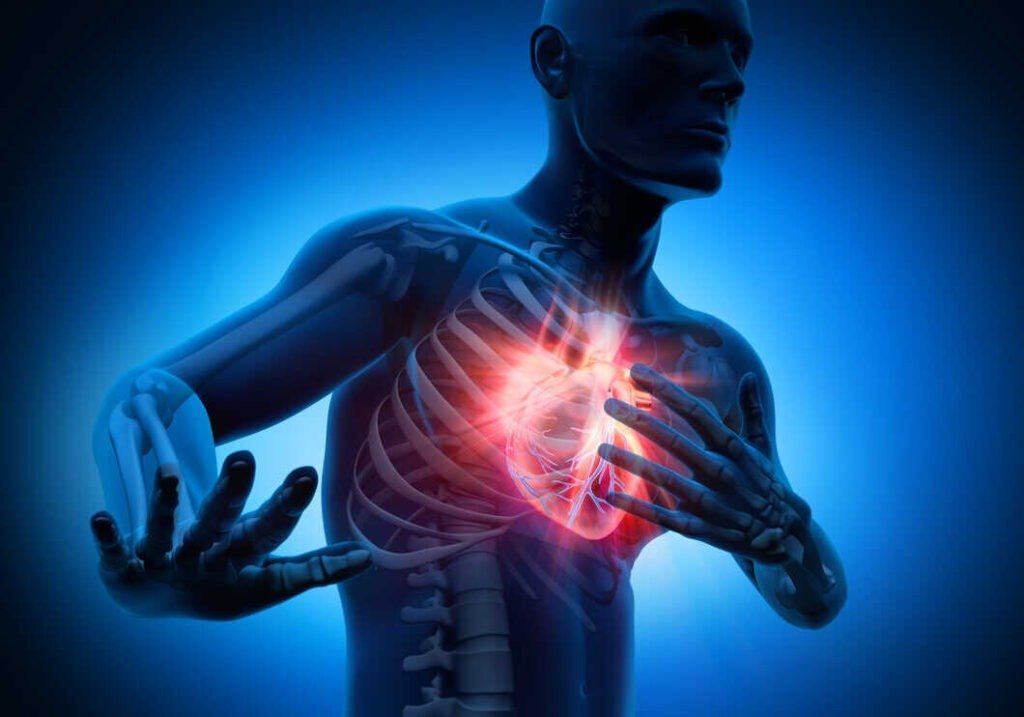
A cardiac arrest is a serious medical emergency that occurs when the blood flow to the heart is blocked. It’s important to recognize the symptoms of a cardiac arrest and seek medical attention immediately.
Symptoms:
- Chest Pain or Discomfort
- Shortness of Breath
- Nausea or Vomiting
- Sweating
A cardiac arrest can happen to anyone at any time. It’s a life-threatening emergency that requires quick action. Knowing what to do in such a situation can mean the difference between life and death.
Step 1: Call your local emergency number. It’s important to stay calm and provide the operator with the necessary information, including the person’s location, their symptoms, and any other pertinent details.
Step 2: While you’re waiting for the ambulance to arrive, you can help the person by having them sit or lie down in a comfortable position. Loosen any tight clothing, such as a tie or collar. If the person is conscious and able to swallow, give them an aspirin to chew on which help to prevent blood clots that can make the situation worse.
Step 3: Perform CPR (cardiopulmonary resuscitation) immediately if the person becomes unconscious and stops breathing. Place one hand on top of the other and position them in the center of the person’s chest. Start compressions by pushing down firmly and quickly.
Step 4: Stay Calm and Reassure the Person It’s important to remain calm and reassuring during this time. Let the person know that help is on the way and that you’re there to help them. If they’re conscious, talk to them and help them stay calm.
2. What to do if someone gets cold and flu?

In Covid-19 Pandemic, cold and flu were the most common symptoms. And due to this nowadays, people get afraid even when they get a common flu. If you or someone you know has caught a cold or flu, it can be an uncomfortable and frustrating experience. However, there are several things you can do to help ease symptoms and speed up recovery time. Here are some tips on what to do if someone gets cold and flu:
Stay hydrated: Drinking plenty of fluids, such as water, herbal tea, or warm soups, can help keep the body hydrated and loosen congestion. Avoid sugary drinks and alcohol, which can dehydrate the body.
Rest: Getting plenty of rest is essential when battling a cold or flu. Take time off work or school, if possible, and allow the body to focus on fighting off the illness.
Use over-the-counter remedies: Over-the-counter cold and flu medicines can help ease symptoms such as fever, coughing, and congestion. However, it’s important to follow the instructions carefully and avoid taking multiple medicines at once.
Practice good hygiene: Colds and flu are highly contagious, so it’s essential to practice good hygiene to avoid spreading the illness. Wash your hands frequently, cover your mouth when coughing or sneezing, and avoid close contact with others.
Use natural remedies: Some people find relief from cold and flu symptoms by using natural remedies, such as honey, ginger, and elderberry. However, it’s essential to talk to your doctor before trying any new remedies, especially if you are taking other medical specialist.
3. What to do if someone has a stroke?
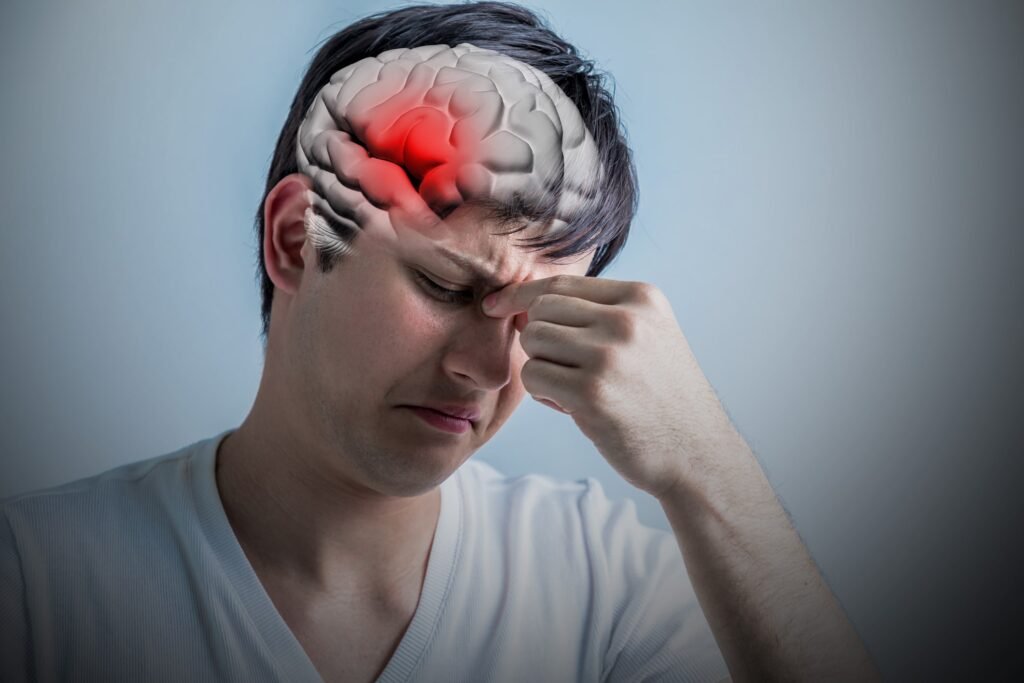
A stroke is a serious medical emergency that requires immediate attention. When someone has a stroke, time is of the essence, and prompt action can make a difference in their recovery.
Symptoms:
- Sudden numbness or weakness on one side of the face, arm, or leg.
- Sudden confusion or trouble speaking or understanding speech.
- Sudden trouble seeing in one or both eyes.
- Sudden trouble walking, dizziness, or loss of balance or coordination.
- Sudden severe headache with no known cause.
So then What to do if someone has a stroke?
Call for Emergency Medical Assistance: Time is of the essence when it comes to stroke, so it is important to call for emergency medical assistance as soon as possible. Provide Basic Care and Comfort: While waiting for emergency medical assistance to arrive, provide basic care and comfort to the person. Helping the person lie down on their side with their head slightly elevated. Loosening any tight clothing around the neck, chest, or waist. Reassuring the person and speaking to them in a calm, soothing voice. Monitoring the person’s breathing and pulse. Do not give the person any food, drink, or medication unless instructed to do so by a medical professional. Recognizing the signs of a stroke and calling for emergency medical assistance as soon as possible can help save a person’s life and prevent long-term disability. Providing basic care and comfort while waiting for medical assistance and following medical instructions can help ensure the best possible outcome for the person.
4. What to do if someone has a seizure?
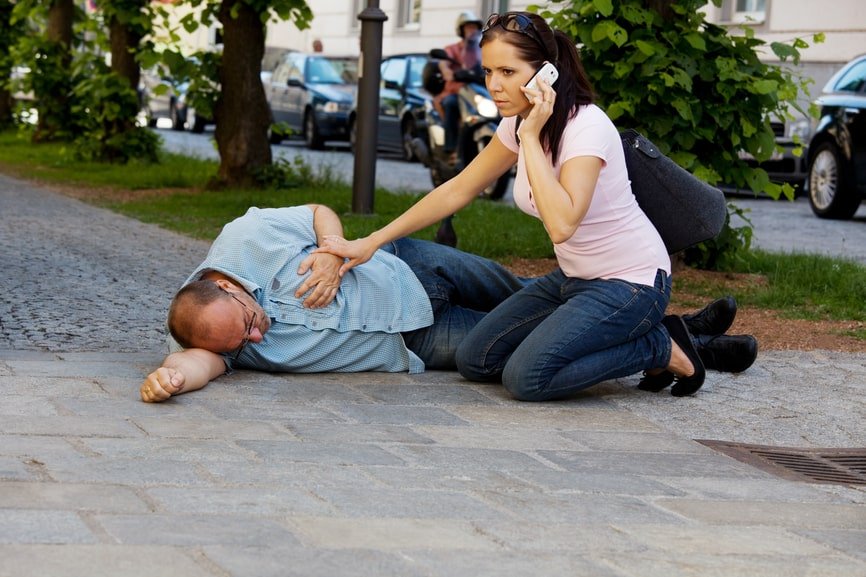
A seizure is a sudden, uncontrolled electrical disturbance in the brain that can cause changes in behavior, movements, or consciousness. Seizures can be caused by a variety of factors, including epilepsy, head injuries, infections, or other medical conditions. If someone has a seizure, it can be a frightening and overwhelming experience for both the person having the seizure and those around them. So what to do if someone has a seizure.
Stay Calm and Safe: The first step in helping someone who has a seizure is to stay calm and safe. It is important to remain with the person and observe the seizure closely. Do not restrain the person or try to hold them down. Clear the area around the person of any sharp objects or dangerous obstacles. If possible, place a soft cushion or pillow under their head to prevent injury. Time the Seizure: Timing the seizure can be helpful in determining the duration of the seizure and the best course of action. If the seizure lasts longer than five minutes or if the person has difficulty breathing or turning blue, call for emergency medical assistance immediately. Protect the Person’s Airway: During a seizure, the person may drool or vomit, which can cause choking or aspiration. Gently roll the person onto their side to protect their airway and prevent choking. If possible, loosen any tight clothing around the neck and chest to aid in breathing. Reassure the Person and Monitor Them: After the seizure has ended, reassure the person and monitor them closely. The person may feel confused, disoriented, or tired after the seizure. It is important to stay with them until they have fully recovered and are alert and responsive. Seek Medical Attention: In some cases, medical attention may be necessary after a seizure. If the person has a seizure for the first time, has a prolonged seizure, or has difficulty breathing after the seizure, seek medical attention immediately. The person may need medication or other treatment to prevent future seizures.
5. What to do if someone gets bit by snake?
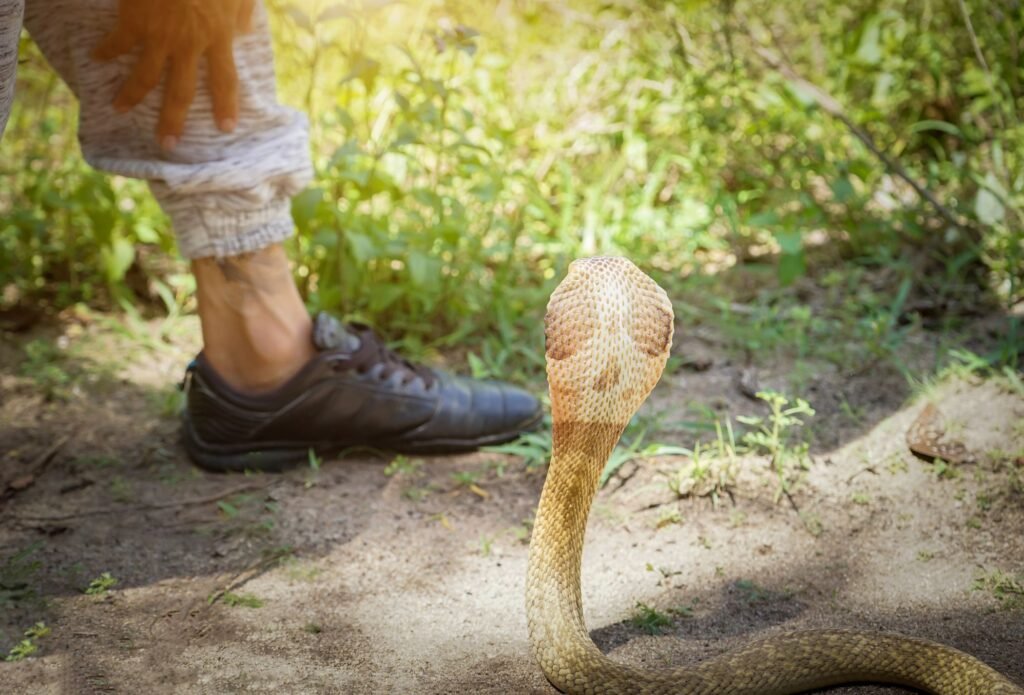
A snake bite can be a potentially life-threatening emergency that requires immediate attention. Snakes are found in many parts of the world, and their bites can cause a range of symptoms, from mild swelling and pain to severe respiratory distress and cardiac arrest. But what to do if someone gets bit by a snake.
Get to Safety: The first step in helping someone who has been bitten by a snake is to get to safety. Move the person away from the snake and to a safe location where you can assess their condition and provide first aid. Call for Emergency Medical Assistance: Call for emergency medical assistance immediately, especially if the person experiences any severe symptoms, such as difficulty breathing, chest pain, or severe swelling. If possible, call ahead to the emergency services to let them know you are on the way and that the person has been bitten by a snake. Keep the Person Calm and Still: Snake bites can be painful and scary, so it is important to keep the person calm and still. Ask them to lie down on their back and elevate the affected limb if possible. Encourage the person to stay calm and avoid moving too much to slow down the spread of venom in their bloodstream. Remove Any Constricting Clothing or Jewelry: If the snake bite is on an arm or leg, remove any constricting clothing or jewelry, such as bracelets, watches, or rings. This will help to prevent swelling and reduce the risk of tissue damage. Clean the Wound: Clean the bite wound with soap and water, but do not try to suck the venom out or cut the wound with a knife. These methods can cause further damage and increase the risk of infection. Apply a Pressure Immobilization Bandage: If you are in a remote area and cannot reach medical assistance quickly, apply a pressure immobilization bandage to the affected limb. This bandage will help to slow down the spread of venom in the bloodstream. Monitor the Person’s Vital Signs: Monitor the person’s vital signs, such as their breathing rate, heart rate, and blood pressure, until emergency medical assistance arrives. If the person becomes unresponsive, begin CPR immediately.
6. What to do if someone is Choking?
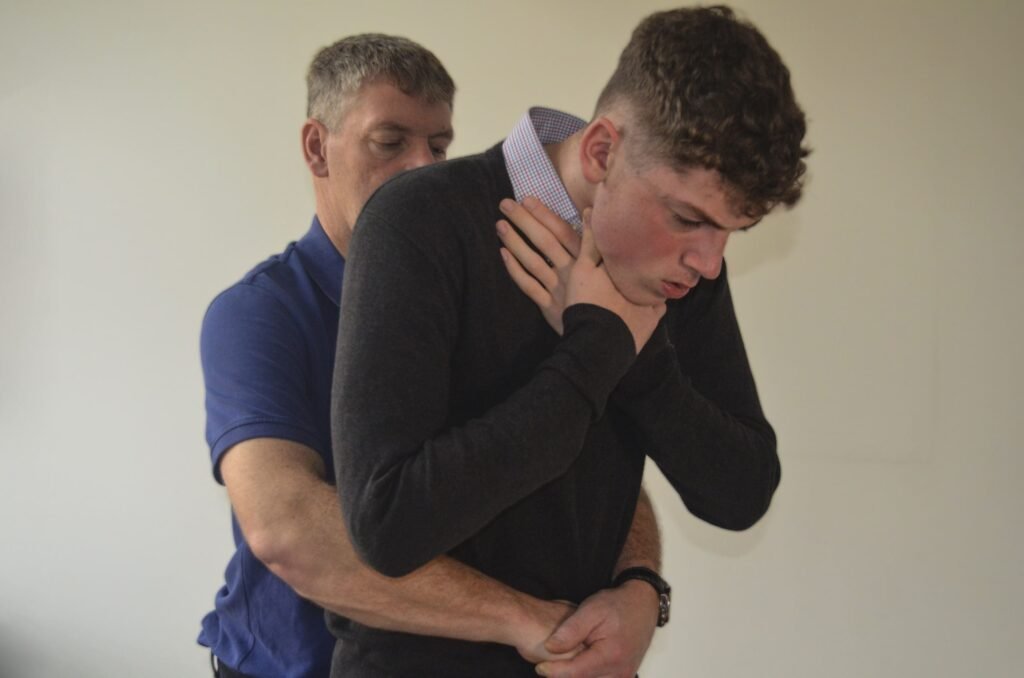
Choking is a common emergency that can occur when a person’s airway becomes partially or fully blocked by an object or piece of food. Choking can be life-threatening and requires immediate attention. So here, we will discuss what to do if someone is choking.
Assess the Severity of the Choking: Assess the severity of the choking by asking the person if they are choking and if they can speak or cough. If the person can speak or cough, encourage them to continue coughing to try and dislodge the object. If the person is unable to speak, cough, or breathe, the situation is more severe and requires immediate action. Perform the Heimlich Maneuver: Perform the Heimlich maneuver if the person is choking and unable to speak, cough, or breathe. To do this, stand behind the person and wrap your arms around their waist. Make a fist with one hand and place it just above the person’s belly button, with your thumb facing inward. Grasp your fist with your other hand and give quick upward thrusts to try and dislodge the object. Repeat the thrusts until the object is dislodged or until emergency medical assistance arrives. Call for Emergency Medical Assistance: Call for emergency medical assistance immediately if the person is choking and unable to speak, cough, or breathe. If you are alone, perform the Heimlich maneuver first, and then call for assistance. Clear the Person’s Airway: If the person becomes unresponsive, clear their airway by tilting their head back and lifting their chin. Look inside the mouth and remove any visible objects or food particles. Perform rescue breathing if necessary. Monitor the Person’s Vital Signs: Monitor the person’s vital signs, such as their breathing rate, heart rate, and blood pressure, until emergency medical assistance arrives. If the person becomes unresponsive, begin CPR immediately.
7. What to do if a child is choking ?
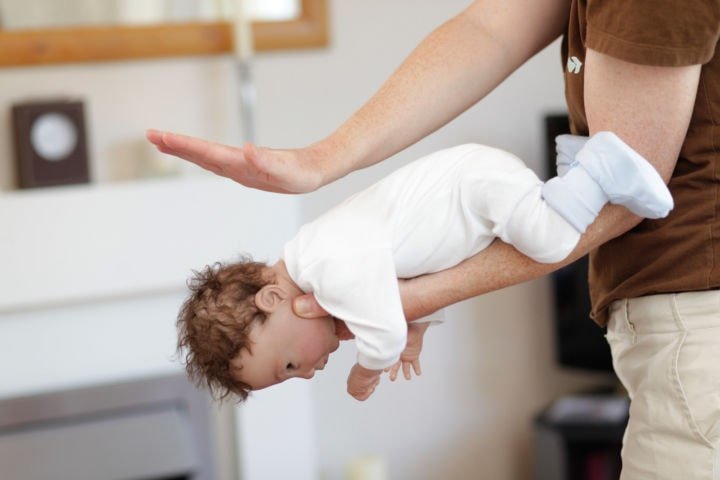
Choking is a common and potentially life-threatening emergency that can happen to anyone, especially children. It’s important to know what to do if a child is choking to help prevent injury or death. Here are some steps to take if you find yourself in this situation:
1. Assess the situation: First, determine whether the child is actually choking. If they’re coughing, gagging, or able to speak, encourage them to keep coughing and avoid intervening. However, if the child is making no noise or sounds, they may be choking and require immediate help. 2. Call for emergency services: If you’re alone with the child, call for emergency services right away. If there are other people around, ask someone to call while you attend to the child. 3. Give back blows: Stand behind the child and lean them forward slightly, supporting their chest with one hand. Use the heel of your other hand to deliver five sharp blows between the child’s shoulder blades. 4. Perform abdominal thrusts: If the back blows haven’t dislodged the object, give the child abdominal thrusts, also known as the Heimlich maneuver. Stand or kneel behind the child, wrap your arms around their waist, and make a fist with one hand. Place your fist above the navel and below the ribcage and use your other hand to push your fist inward and upward in a quick, upward thrust. Repeat up to five times, checking the child’s mouth after each thrust. 5. Continue until help arrives: Repeat steps three and four until the object is dislodged or emergency services arrive. If the child becomes unconscious, start CPR.
Choking is a serious emergency that requires prompt and decisive action. Remember to stay calm, act quickly, and seek medical attention as soon as possible. With the right knowledge and preparedness, you can help keep children safe from harm.
8. What to do if a dog bites you ?
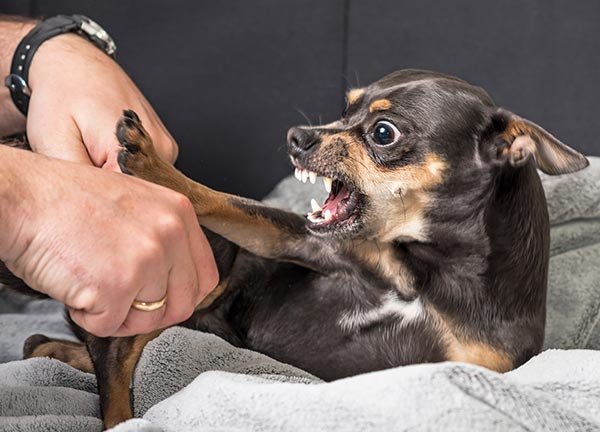
Dogs are considered man’s best friend, but even the friendliest dogs can bite in certain situations. If a dog has bitten you, it’s important to take quick and appropriate action to prevent infection and ensure proper healing. Here’s what you should do if a dog bites you:
Clean the wound: The first step is to clean the wound thoroughly with soap and water. Use warm water and mild soap to gently wash the area around the bite, being careful not to scrub the wound. Rinse with clean water and pat dry with a clean towel. Apply an antiseptic: After cleaning the wound, apply an antiseptic cream or ointment to the bite area. This will help to prevent infection and promote healing. Cover the wound: Cover the wound with a sterile bandage or gauze pad to protect it from dirt and bacteria. Change the bandage or pad regularly and watch for signs of infection such as redness, swelling, or pus. Seek medical attention: If the wound is deep or bleeding heavily, seek medical attention right away. A doctor may prescribe antibiotics or recommend a tetanus shot depending on the severity of the wound. Report the bite: It’s important to report the dog bite to the appropriate authorities, especially if the dog is unknown or unvaccinated. Contact your local animal control agency or police department to report the bite.
In addition to these steps, it’s important to take measures to prevent future bites. Always approach dogs with caution, especially if you’re unfamiliar with them. Avoid making direct eye contact, and let the dog sniff you before petting it. If a dog seems aggressive or agitated, stay away and give it space.
Remember to report the bite to the proper authorities and take steps to prevent future bites. With these precautions, you can help protect yourself from dog bites and ensure a speedy recovery.
9. What to do if a person is electrocuted?

Electric shock or electrocution can happen to anyone and can be a life-threatening emergency. Knowing what to do in case of an electrocution can be critical in saving a person’s life. If you ever encounter such an emergency situation, here is a quick guide on what to do if a person is electrocuted.
CAUTION : 1) Never touch a person who is electrocuted, electric current may still be passing through his body. So instead use a non- conducting object to move the affected person. 2) If the source is lightning or high-voltage wires, don’t go near by yourself, instead call the Emergency officials.
What to do if someone is electrocuted? The first and most important step is to ensure your own safety. Do not touch the person or the source of the electricity if there is water present. Instead, turn off the power source or unplug the device that is causing the electrocution if possible. Call for emergency help: Call 911 or your local emergency number immediately if the person is unresponsive, has burns or injuries, or is having difficulty breathing. Time is of the essence in these situations, and quick action can save a person’s life. Check for breathing: Check if the person is breathing and if they have a pulse. If not, begin CPR immediately. Even if the person is breathing and conscious, it’s important to seek medical attention to ensure there are no internal injuries or delayed symptoms. Do not move the person: Avoid moving the person unless absolutely necessary. Moving the person could cause further injury, especially if there are burns or fractures. Electrocution can be a life-threatening emergency, and it’s important to know what to do if a person is electrocuted. Remember to turn off the power source, call for emergency help, check for breathing, and avoid moving the person. Quick action can make all the difference in saving a person’s life
10. What to do if a person is on Fire?
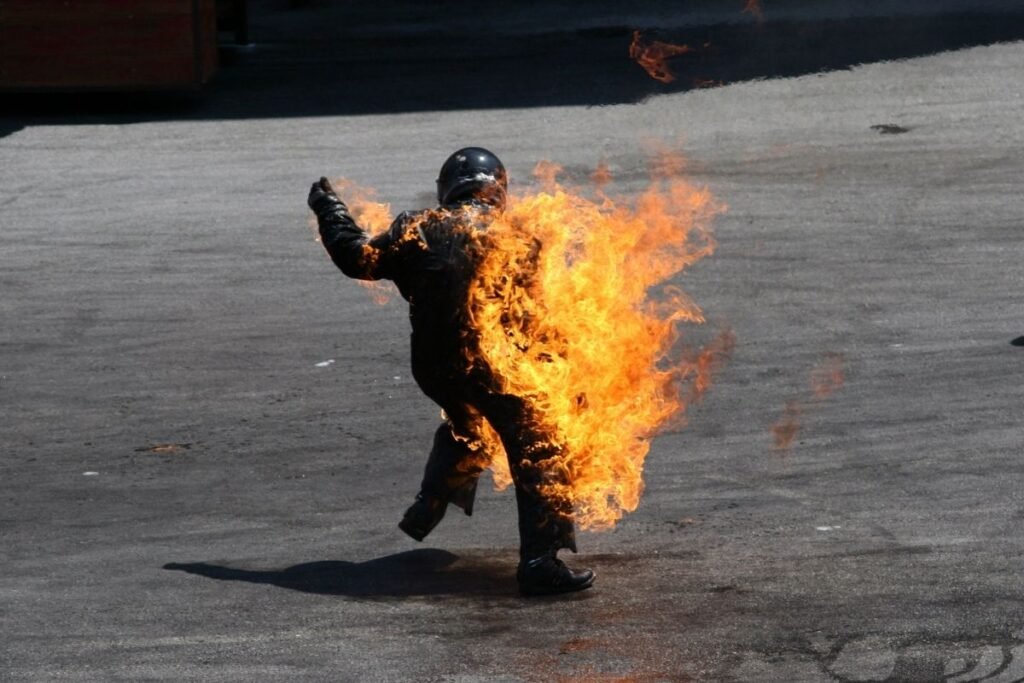
A person on fire is a terrifying sight, but knowing what to do in this situation can save a person’s life. Here’s a quick guide on what to do if a person is on fire.
Stop, drop, and roll: The first and most important thing to do is to tell the person to stop, drop, and roll. This can help extinguish the flames and prevent the fire from spreading. Encourage the person to cover their face and mouth to avoid inhaling smoke. Smother the flames: If the person cannot stop, drop, and roll, grab a blanket, coat, or any other available fabric and use it to smother the flames. Do not use water or any other liquid, as this can make the fire worse. Call for emergency help: Call Emergency contact number or your local emergency number immediately, even if the fire has been extinguished. Burns can be serious and require medical attention. Remove any burned clothing: Once the fire has been extinguished, remove any burned clothing that is not stuck to the person’s skin. Do not attempt to remove anything that is stuck to the skin, as this can cause further injury. Cool the burns: If the person has sustained burns, run cool water over the affected area for at least 10 minutes. This can help reduce pain and prevent further damage. Knowing what to do if a person is on fire can be critical in saving a person’s life. Remember to tell the person to stop, drop, and roll, smother the flames, call for emergency help, remove any burned clothing, and cool the burns. Quick action can make all the difference in handling an emergency situation.
11. What to do if someone is drowning?

Drowning is a serious and potentially fatal emergency that can happen to anyone. It can occur suddenly and silently, without any warning signs. Knowing what to do if someone is drowning can make a significant difference in saving their life. In this article, we will provide a quick guide on what to do if someone is drowning.
Call for Help – The first thing you need to do is call for help. Call your local emergency number immediately. Time is of the essence in a drowning situation, and the quicker you get help, the better the chances of survival. Remove the Person from the Water – If the person is still in the water, you should remove them from the water as quickly and safely as possible. Be careful not to endanger yourself in the process. Check for Breathing and Pulse – Once the person is out of the water, check for breathing and pulse. If the person is not breathing or has no pulse, start CPR immediately. Administer CPR – If you are trained in CPR, start administering it to the person. Chest compressions and rescue breathing can help oxygenate the body and increase the chances of survival. Monitor the Person’s Vital Signs – Continue to monitor the person’s breathing and pulse until help arrives. If the person regains consciousness, keep them calm and warm until medical help arrives Provide Emotional Support – A drowning incident can be traumatic, not just for the person involved, but for witnesses as well. Be sure to provide emotional support to everyone involved and offer counseling if needed.
Preventing Drowning:
Prevention is always better than cure, and there are many ways to prevent drowning incidents. Here are some tips to help prevent drowning:
Always supervise children near water, whether it is a pool, beach, or bathtub. Teach children how to swim at an early age. Wear life jackets when boating or participating in water activities. Do not swim alone. Do not drink alcohol before swimming or boating.
